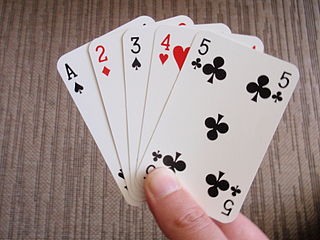
A playing card is a piece of specially prepared card stock, heavy paper, thin cardboard, plastic-coated paper, cotton-paper blend, or thin plastic that is marked with distinguishing motifs. Often the front (face) and back of each card has a finish to make handling easier. They are most commonly used for playing card games, and are also used in magic tricks, cardistry, card throwing, and card houses; cards may also be collected. Playing cards are typically palm-sized for convenient handling, and usually are sold together in a set as a deck of cards or pack of cards.

Tarot is a pack of playing cards, used from at least the mid-15th century in various parts of Europe to play card games such as Tarocchini. From their Italian roots, tarot-playing cards spread to most of Europe, evolving into a family of games that includes German Grosstarok and modern games such as French Tarot and Austrian Königrufen. In the late 18th century French occultists made elaborate, but unsubstantiated, claims about their history and meaning, leading to the emergence of custom decks for use in divination via tarot card reading and cartomancy. Thus, there are two distinct types of tarot packs in circulation: those used for card games and those used for divination. However, some older patterns, such as the Tarot de Marseille, originally intended for playing card games, are occasionally used for cartomancy.

The Major Arcana are the named or numbered cards in a cartomantic tarot pack, the name being originally given by occultists to the trump cards of a normal tarot pack used for playing card games. There are usually 22 such cards in a standard 78-card pack, typically numbered from 0 to 21. The name is not used by tarot card game players.

The Rider–Waite Tarot is a widely popular deck for tarot card reading. It is also known as the Waite–Smith, Rider–Waite–Smith, or Rider Tarot. Based on the instructions of academic and mystic A. E. Waite and illustrated by Pamela Colman Smith, both members of the Hermetic Order of the Golden Dawn, the cards were originally published by the Rider Company in 1909. The deck has been published in numerous editions and inspired a wide array of variants and imitations. It is estimated that more than 100 million copies of the deck exist in more than 20 countries.

The Magician (I), also known as The Magus or The Juggler, is the first trump or Major Arcana card in most traditional tarot decks. It is used in game playing and divination; in the English-speaking world, the divination meaning is much better known.

In playing cards, a suit is one of the categories into which the cards of a deck are divided. Most often, each card bears one of several pips (symbols) showing to which suit it belongs; the suit may alternatively or additionally be indicated by the color printed on the card. The rank for each card is determined by the number of pips on it, except on face cards. Ranking indicates which cards within a suit are better, higher or more valuable than others, whereas there is no order between the suits unless defined in the rules of a specific card game. In a single deck, there is exactly one card of any given rank in any given suit. A deck may include special cards that belong to no suit, often called jokers.

The Hanged Man (XII) is the twelfth Major Arcana card in most traditional tarot decks. It is used in game playing as well as in divination.
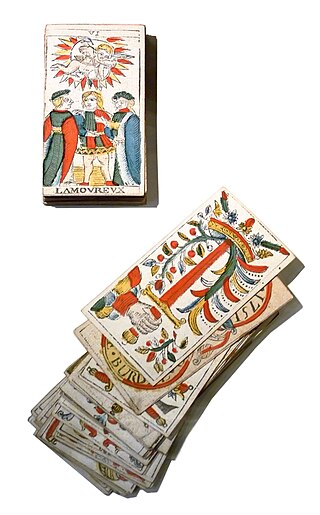
The Tarot of Marseilles is a standard pattern of Italian-suited tarot pack with 78 cards that was very popular in France in the 17th and 18th centuries for playing tarot card games and is still produced today. It was probably created in Milan before spreading to much of France, Switzerland and Northern Italy. The name is sometimes spelt Tarot of Marseille, but the name recommended by the International Playing-Card Society is Tarot de Marseille, although it accepts the two English names as alternatives. It was the pack which led to the occult use of tarot cards, although today dedicated decks are produced for this purpose.
Minchiate is an early 16th-century card game, originating in Florence, Italy. It is no longer widely played. Minchiate can also refer to the special deck of 97 playing cards used in the game. The deck is closely related to the tarot cards, but contains an expanded suit of trumps. The game was similar to but more complex than tarocchi. The minchiate represents a Florentine variant on the original game.
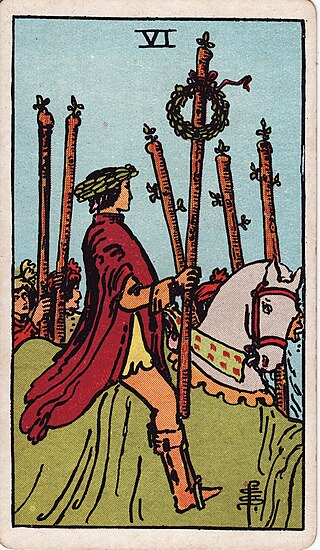
The Six of Wands, or Six of Batons, is a card used in Latin-suited playing cards, which include tarot decks. It is part of what tarot card readers call the "Minor Arcana," the six of wands cards in divination decks with illustrated pip cards, displays a laureled horseman bearing a staff adorned with laurel crown. Footmen with staves are at his side.

The Three of Cups is the third card on the suit of cups. In tarot, it is part of the Minor Arcana. In some decks the suit is named chalices or goblets instead. This card is used in game playing as well as in divination.
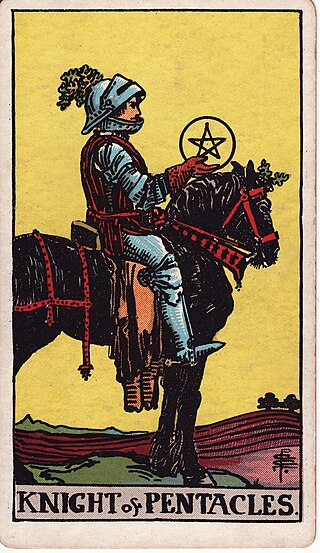
The Knight of Coins is a card used in Latin-suited playing cards which include tarot decks. It is part of what tarot card readers call the "Minor Arcana". The coins" suit is sometimes referred to as "pentacles" or "discs" instead.
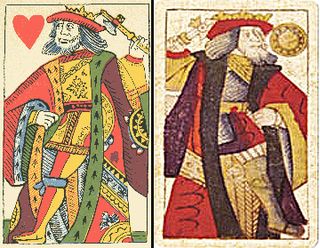
King of Coins is a card used in Latin-suited playing cards. It is the king from the suit of coins. In Tarot, it is part of what tarot card readers call the "Minor Arcana".
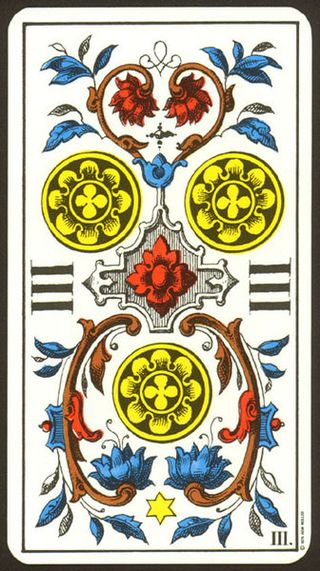
The suit of coins is one of the four suits used in tarot decks with Latin-suited cards. It is derived from the suit of coins in Italian and Spanish card playing packs.

The suit of goblets, more often known in modern times as the Suit of Cups, is one of four suits of tarot which, collectively, make up the Minor Arcana. They are sometimes referred to as chalices. Like the other suits of the Minor Arcana, it contains fourteen cards: ace (one), two through ten, page, knight, queen and king. Historically, the suit represented the First Estate. Tarot cards were originally designed for card play and are still used throughout much of Europe to play various Tarot card games. However, in English-speaking countries, where the games are largely unknown, Tarot cards came to be utilized primarily for divinatory purposes. In modern card games, the equivalent suits are Hearts or Cups.

The suit of swords is one of the four suits of the Minor Arcana in a 78-card cartomantic tarot deck. It is derived from the suit used in Latin-suited playing cards, such as Spanish, Italian and Latin-suited tarot decks. Like the other tarot suits, it contains fourteen cards: ace (one), two through ten, page, knight, queen and king. Occultists claim that the suit represents the Second Estate.

Tarot card reading is a form of cartomancy whereby practitioners use tarot cards to purportedly gain insight into the past, present or future. They formulate a question, then draw cards to interpret them for this end. A traditional tarot deck consists of 78 cards, which can be split into two groups, the Major Arcana and Minor Arcana. French-suited playing cards can also be used; as can any card system with suits assigned to identifiable elements.

Tarot games are card games played with tarot packs designed for card play and which have a permanent trump suit alongside the usual four card suits. The games and packs which English-speakers call by the French name Tarot are called Tarocchi in the original Italian, Tarock in German and similar words in other languages.
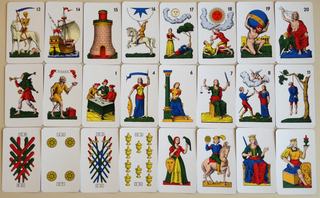
The Tarocco Siciliano is a tarot deck found in Sicily and is used to play Sicilian tarocchi. It is one of the three traditional Latin-suited tarot decks still used for games in Italy, the others being the more prevalent Tarocco Piemontese and the Tarocco Bolognese. The deck was heavily influenced by the Tarocco Bolognese and the Minchiate. It is also the only surviving tarot deck to use the Portuguese variation of the Latin suits of cups, coins, swords, and clubs which died out in the late 19th and early 20th centuries.

The Fool is one of the 78 cards in a tarot deck. In tarot card reading, it is one of the 22 Major Arcana, sometimes numbered as 0 or XXII. However, in decks designed for playing traditional tarot card games, it is typically unnumbered, as it is not one of the 21 trump cards and instead serves a unique purpose by itself.



















